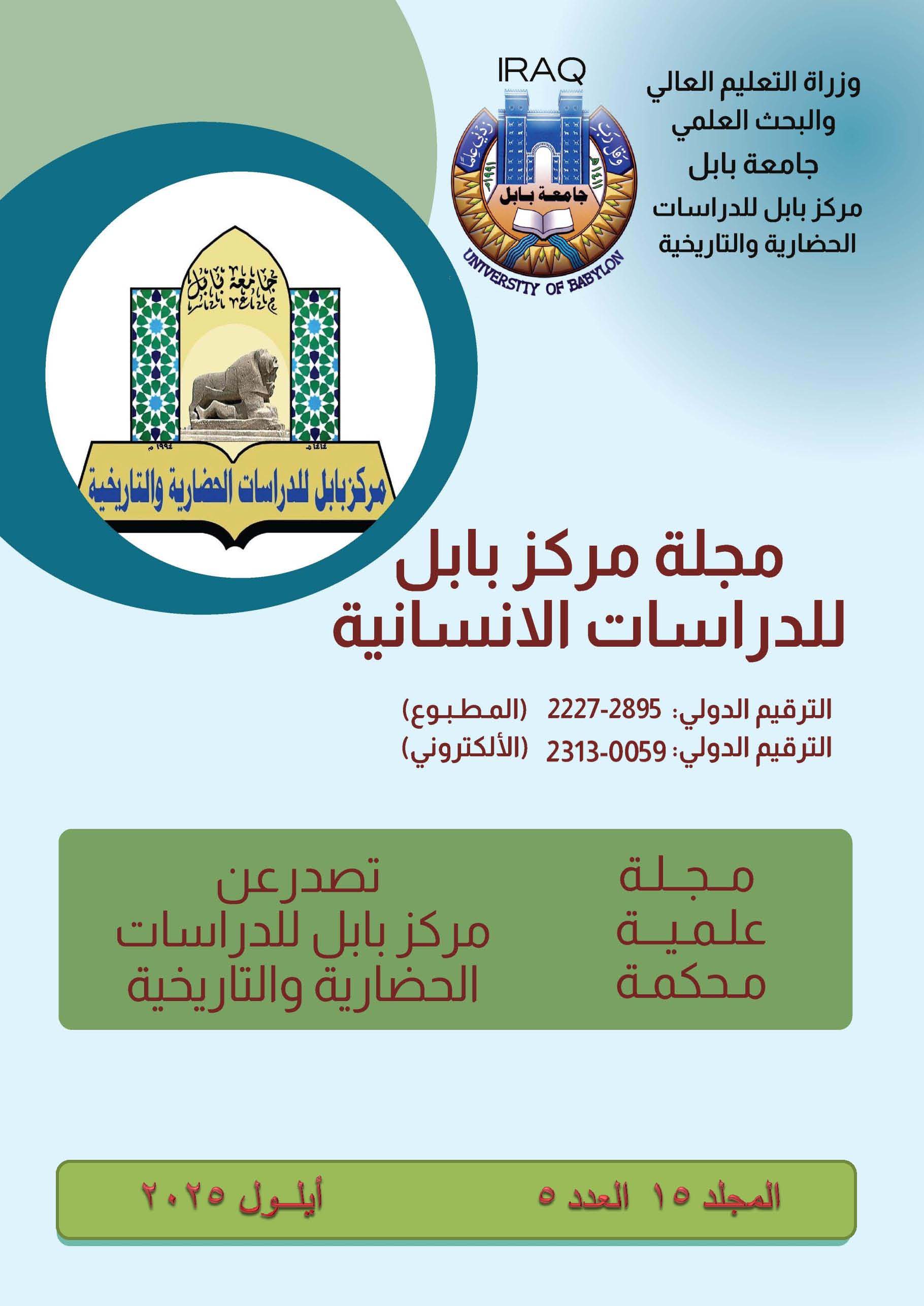Abstract
After this, this research was carried out in the poets of the sixth class of the pre-Islamic poets, which Ibn Salam included in his book Layers and the Legends of the Poets, in which I tried to search for objective and technical reasons that made Ibn Salam put both: (Amr bin Kulthum, Al-Harith bin Hillazah, Antara bin Shaddad and Suwaid Bin Abi Kahl) in one layer.
The research came in the introduction and introduction, in which the researcher touched on some of the issues that were in question, especially the foundations upon which Ibn Salam used his classes, and the references he adopted as a basis for those monetary values resulting from his classification of the classes.
The research included two topics: the first is entitled: the foundations and standards adopted by Ibn Salamam in his division of the classes, and the second is entitled: Reading in the poets of the sixth class, which is the essence of the research, then came the conclusion, which is a conclusion I concluded during its journey with research in the common denominators of the four poets.
The researcher relied on a group of ancient sources of criticism, and a set of studies that focused on the history of criticism in the pre-Islamic era, until the fourth century AH, trying - as much as it could - not to lean towards the seriousness of the supposed objective criticism, and the researcher does not claim perfection, and God is the guardian of success
The research came in the introduction and introduction, in which the researcher touched on some of the issues that were in question, especially the foundations upon which Ibn Salam used his classes, and the references he adopted as a basis for those monetary values resulting from his classification of the classes.
The research included two topics: the first is entitled: the foundations and standards adopted by Ibn Salamam in his division of the classes, and the second is entitled: Reading in the poets of the sixth class, which is the essence of the research, then came the conclusion, which is a conclusion I concluded during its journey with research in the common denominators of the four poets.
The researcher relied on a group of ancient sources of criticism, and a set of studies that focused on the history of criticism in the pre-Islamic era, until the fourth century AH, trying - as much as it could - not to lean towards the seriousness of the supposed objective criticism, and the researcher does not claim perfection, and God is the guardian of success
Keywords
Ibn Salam
Tabqa
the factors of limelight
Abstract
وبعدُ فهذا بحث في شعراء الطبقة السادسة من شعراء الجاهلية، التي ضمنها ابن سلّام في كتابه طبقات فحول الشعراء، حاولت فيه البحث عن الأسباب الموضوعية والفنية التي جعلت ابن سلّام يضع كلًّا من:(عمرو بن كلثوم، والحارث بن حلّزة، وعنترة بن شداد، وسويد بن أبي كاهل) في طبقة واحدة.
وقد تجنبتُ فيه ما جاء على لسان ابن سلّام فيهم داخل الطبقة؛ بغية الاطمئنان بوجود قواسم مشتركة بين الشعراء الأربعة، وجعلتْهم ينضوون داخل طبقة واحدة؛ لينطبق علينا حقيقة قراءة النص بشكل معكوس. أي قراءة حيثيات كلّ شاعر؛ الفنية، والموضوعية الناتجة عن قراءة شعرهم، واقتناص الأغراض السائدة لديهم، والتي تكررت في شعرهم بشكل مطّرد، علماً أنّ الباحثة، قد عدّت مسألة اتفاقهم بكونهم من الشعراء المعمّرين الذين عاشوا طويلاً مسألةً مسلماً بها، فأخذت على عاتقها السفر في تفاصيل حياة كل شاعر منهم.
فجاء البحث في مقدمة وتمهيد، تطرقت فيه الباحثة إلى بعض القضايا التي كانت محل تساؤل، لا سيما الأسس التي استند إليها ابن سلّام في طبقاته، والمرجعيات التي اعتمدها أساساً لتلك القيم النقدية الناتجة عن تصنيفه للطبقات.
وتضمن البحث مبحثين: الأول عنوانه: الأسس والمقاييس التي اعتمدها ابن سلّام في تقسيمه للطبقات، والثاني عنوانه: قراءة في شعراء الطبقة السادسة، وهو جوهر البحث، ثم جاءت الخاتمة التي هي خلاصة استنتجتها خلال رحلتها مع البحث في القواسم المشتركة لدى الشعراء الأربعة.
واعتمدت الباحثة على مجموعة من مصادر النقد القديم، ومجموعة من الدراسات التي اهتمت بتاريخ النقد في العصر الجاهلي، حتى القرن الرابع الهجري، محاوِلة - قدر استطاعتها- عدم الميل عن جادّة النقد الموضوعي المفترض، ولا تدعي الباحثة الكمال، والله ولي التوفيق.
وقد تجنبتُ فيه ما جاء على لسان ابن سلّام فيهم داخل الطبقة؛ بغية الاطمئنان بوجود قواسم مشتركة بين الشعراء الأربعة، وجعلتْهم ينضوون داخل طبقة واحدة؛ لينطبق علينا حقيقة قراءة النص بشكل معكوس. أي قراءة حيثيات كلّ شاعر؛ الفنية، والموضوعية الناتجة عن قراءة شعرهم، واقتناص الأغراض السائدة لديهم، والتي تكررت في شعرهم بشكل مطّرد، علماً أنّ الباحثة، قد عدّت مسألة اتفاقهم بكونهم من الشعراء المعمّرين الذين عاشوا طويلاً مسألةً مسلماً بها، فأخذت على عاتقها السفر في تفاصيل حياة كل شاعر منهم.
فجاء البحث في مقدمة وتمهيد، تطرقت فيه الباحثة إلى بعض القضايا التي كانت محل تساؤل، لا سيما الأسس التي استند إليها ابن سلّام في طبقاته، والمرجعيات التي اعتمدها أساساً لتلك القيم النقدية الناتجة عن تصنيفه للطبقات.
وتضمن البحث مبحثين: الأول عنوانه: الأسس والمقاييس التي اعتمدها ابن سلّام في تقسيمه للطبقات، والثاني عنوانه: قراءة في شعراء الطبقة السادسة، وهو جوهر البحث، ثم جاءت الخاتمة التي هي خلاصة استنتجتها خلال رحلتها مع البحث في القواسم المشتركة لدى الشعراء الأربعة.
واعتمدت الباحثة على مجموعة من مصادر النقد القديم، ومجموعة من الدراسات التي اهتمت بتاريخ النقد في العصر الجاهلي، حتى القرن الرابع الهجري، محاوِلة - قدر استطاعتها- عدم الميل عن جادّة النقد الموضوعي المفترض، ولا تدعي الباحثة الكمال، والله ولي التوفيق.
Keywords
الطبقة، ابن سلّام، عوامل الانضواء
